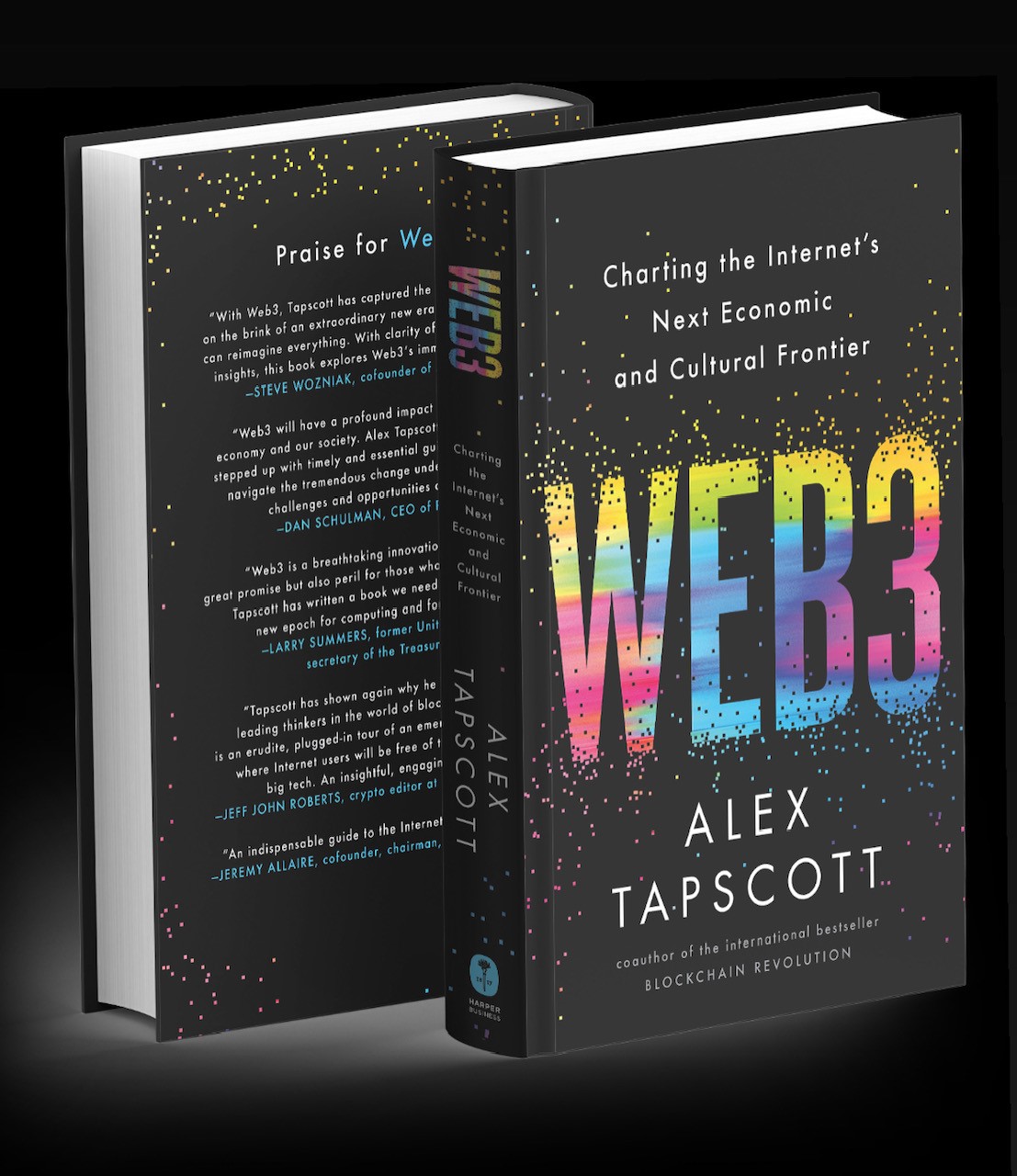A research report published by Spherical Insights & Consulting found that the global Web3 market size was valued at $1.82 billion in 2022. According to the report, this number is expected to reach $67.92 billion by 2032.
Yet while the potential behind Web3 is massive, confusion remains when it comes to understanding what Web3 is and the value the technology can provide.
Web3: The Next Era of The Internet
Author and Managing Director at Ninepoint Partners investment firm Alex Tapscott told Cryptonews that he believes Web3 has created a new asset class from scratch. He noted that the mainstream wouldn’t understand this just by reading popular business press, however.
Tapscott’s recent book, Web3: Charting the Internet’s Next Economic and Cultural Frontier, provides a number of real-world examples that explain in simple terms how entrepreneurs and enterprises are leveraging Web3.
“I wrote this book to reset the conversation around Web3 and to explain to a mainstream audience why this new internet is such a powerful force for cultural, social, and economic change,” Tapscott said.

Indeed, Tapscott details a variety of Web3 business use cases throughout his book, allowing readers who may not be familiar with blockchain technology or cryptocurrency to grasp underlying concepts.
“I felt the need to wipe the mud off the windshield and give a clear-eyed take on all that has transpired and what’s to come,” said Tapscott. “In other words, the time has come, again, to explain to the world why they should care about web3.”
What Exactly is Web3?
In order to help readers understand the concepts behind Web3, the first few chapters of Web3: Charting the Internet’s Next Economic and Cultural Frontier provide a broad overview of the different eras of the Internet.
For example, Tapscott explains that the first era of the Web—Web1—served as a platform for sharing digital information such as mail, newspapers, magazines, and the like.
Following this, Web2 was developed, which allowed for things such as social networking and e-commerce to be leveraged across mobile devices. While notable, this era of the Web still lacked ownership rights for users publishing content.
“Social media giants like Facebook and Twitter enabled individuals to create and publish their own content, form groups and collaborate online, but users couldn’t attach clear ownership rights to their content,” Tapscott writes.
Given these downsides, Tapscott goes on to explain that a new web was conceived following the financial crisis of 2008. It was during this time that the Bitcoin white paper was released, which allowed the public to understand how value could be sent over the Internet.
According to Tapscott, Web3 was eventually developed in 2020 to represent the “Internet of value.”
Real-World Business Use Cases
While the first part of Tapscott’s book lays the foundation for understanding Web3 and how it came about, the chapters in part two go in-depth on real-world use cases.
For instance, chapter three explains how tokenized assets are the building blocks of Web3. Tapscott notes that major corporations like Nike, Microsoft, and others have all begun to use tokenized assets for business.
To put this in perspective, Nike’s recent RTFKT Dunk Genesis sneakers are tied to non-fungible tokens (NFTs) with an embedded near-field communication (NFC) chip within the sneakers. This allows for a digital redemption of the physical sneaker, providing additional forms of utility.
gm
we have more to share, but meanwhile, you can enjoy the Sunday trying the RTFKT x Nike Dunk Genesis CryptoKicks Sneaker in ARHave fun with the Future and tag us from your Simulation
https://t.co/frD4XMZoPA pic.twitter.com/e3WEmoCfca
— RTFKT (@RTFKT) April 24, 2022
Chapter five of Tapscott’s book is also interesting, as this section goes in-depth on how Web3-native organizations are transforming business and disrupting traditional enterprise.
For instance, Tapscott writes that distributed autonomous organizations, or DAOs, are “global, decentralized and Internet-native organizations, built on a model of token ownership.”
“If LLCs were the foundation of the industrial age, then DAOs may prove to be the foundation of Web3 and the next digital age,” Tapscott remarked. This may very well be the case, as a number of DAOs have been developed within the last few years.
“The emergence of these token-based Internet-native organizations (DAOs) represents the biggest disruption to business and the firm since the invention of the limited liability company two hundred years ago,” Tapscott writes.
The Importance of Crypto Tokens
In addition to explaining use cases, Tapscott points out other important Web3 features, like tokens. This is critical to understand, as the mainstream may associate tokens only with cryptocurrencies.
Yet Tapscott writes that tokens are programmable, self-custodial, permissionless, censorship-resistant, and can be collateralized or uncollateralized. He further explains that tokens are transferable peer-to-peer, which is extremely important for moving value in the Web3 era.
“Tokens are the defining tools of Web3, animating its varied applications, just as websites defined Web1,” Tapscott writes.
He further explains that tokens’ value relies on blockchains, as these distributed ledgers “act as a single source of truth for asset ownership and provenance.” Additionally, he details the eleven types of tokens that may be killer assets for Web3.
For example, Tapscott highlights stablecoins as the primary medium of exchange in Web3. This could be, as stablecoins continue to grow in popularity. For instance, the crypto issuer Circle recently reported a major increase in remittances flowing through Asia using its USDC stablecoin.
Gaming and The Metaverse
The chapters on gaming and the metaverse are also important sections of Tapscott’s book, as these two elements are often associated with Web3. “The metaverse is one of the hottest topics in business,” writes Tapscott.
In order to explain what the metaverse is, Tapscott includes quotes from a number of different industry leaders. He uses a definition from the CEO and Founder of Animoca Brands Yat Siu, which mentions how the metaverse is the construction of new shared realities. Siu also explains how Web3 will be built around societies that exist and operate in the metaverse.
While some individuals may identify the metaverse with applications like Facebook, Tapscott clarifies this by writing, “The Web3 vision for the metaverse is about freedom on a new plane of human existence that mimics the same autonomy and rights we have in our physical world.”
In other words, Tapscott explains that Web3 is needed to secure rights and privileges against centralized entities. He notes that the biggest risk to the metaverse is for it to take the same form as Web2 models, where “users lack rights or ownership of their data or digital selves.”
This notion is also applied to the chapter where Tapscott discusses Web3 gaming models. He begins by writing, “In Web2, gamers may pay for digital goods, but they do not own them.”
The rise of Web3 has finally enabled gamers to own their in-game digital assets, however. In order to put this in perspective, Tapscott shares a viewpoint from Ria Lu of Web3 gaming startup Laguna Games.
“Lu said the Web3 gaming experience is a little different from the Web2 game because I don’t have to lose everything that I put in,” he writes. “On the player side, owning tokens creates a Web3 community and may lead to more collaboration and connections among players.”
Helping Readers Understand Web3’s Value
Overall, Web3: Charting the Internet’s Next Economic and Cultural Frontier provides readers with an easy-to-understand view of Web3. Tapscott does an excellent job of breaking down complex concepts, such as tokenization and DAOs, making these terms relatable to real-world experiences.
He also touches on other technologies driving Web3 such as artificial intelligence, virtual reality, and The Internet of Things. However, Tapscott does not get overly technical, making this book ideal for a non-technical audience.
While Web3 is portrayed as being a revolutionary technology throughout the book, Tapscott ends by pointing out adoption challenges. For instance, he mentions that businesses and enterprises may prefer centralized technology since this has become the norm.
In addition, concerns around energy usage from certain blockchain networks may create opposition toward Web3. There is also a growing misconception that criminals prefer to use cryptocurrency for illicit activities.
Given these challenges, Tapscott writes that individuals and enterprises may be slower to adopt Web3 in comparison to the first or second eras of the Web. He firmly believes that Web3 is the internet’s next economic and cultural frontier, however. This notion is highlighted throughout the book for readers to grasp and reflect upon.
The post Web3 Importance Highlighted in Alex Tapscott’s New Book appeared first on Cryptonews.















